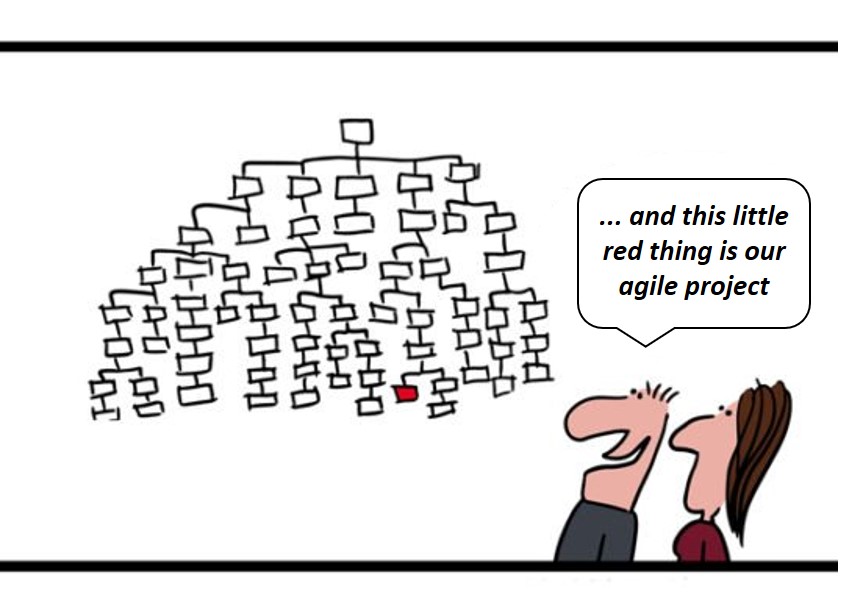As you can see from my CV, between 2006 and 2016 I left the corporate world, so to speak. Not that I would like to say, that I deliberately stayed away from all new developments, but when you no longer work every day in the environment of a larger company, some new trends simply pass by. I have always been interested in technology and you can actively follow technological developments, even if you no longer have to deal with them on a daily basis. Things look a little different, when it comes to new working methods and management styles. So practically, when I re-entered the corporate world, I had to get used to the fact, that everything is “agile” now. Project management, product development, internal processes, management style, the organization and so on, basically the whole working environment. Additionally, there are new keywords like Design Thinking, Scrum, Sprint, User Story and you find new positions in the company like the Scrum Master or the Agile Coach.
Rigid working methods had their time
I am definitely not one of those people, who follow the rule “in the past everything was much better” or ask themselves all the time “why do I need all this modern nonsense”. It is quite the opposite. As described in my blog “The Strategic Inflection Point”, I am rather convinced, that companies, especially in the technology sector, must be very agile these days in order to survive in the long term. Rigid working methods and inflexible organizations definitely had their time. Even public administrations must or should face this challenge today.
There are countless definitions of the term agility related to the management of an organization. I personally like the following one on Wikipedia (translated from German):
“Agility is a characteristic of the management of an organization (enterprise, non-profit organization or public authority) to act flexibly, proactively and anticipatively to introduce necessary changes”.
Agile companies were always more successful
Agile companies have definitely always existed, even before a new theory was created around that term. In most cases, or actually always, they are exactly those companies, that after many years are still successful today, even if some of them have been written off a few times. Intel, Microsoft, Apple and SAP are some of the well-known examples. But even smaller players like Otto should be mentioned here, a meanwhile 70 years old mail order company with headquarters in Hamburg, which printed and mailed its famous Otto catalogues until the end of 2018. Today, the company is better known to many younger people as “otto.de” and even Amazon acknowledges them as their biggest competitor in Germany. While other large German mail order companies like Quelle have disappeared from the market since a long time, Otto has managed to turn things around, converting its business from catalogue ordering to an online shop and also creating a new, more modern brand image. A lot of other companies like the already mentioned mail order company Quelle, but also big names like AOL, Sun Microsystems, Yahoo or Compaq do not play a significant role anymore or have completely disappeared from the market, although they were once leaders in their respective areas.
An example from Germany
The German corporation Nixdorf Computer AG, once the flagship of the German IT industry, was then merged with the IT division of Siemens to form the new company Siemens-Nixdorf, before the name Nixdorf finally disappeared completely after the takeover by Fujitsu. Unfortunately, all the latter companies did not act proactively and anticipatively, but more or less rested on their success and did not notice, that the market was about to change fundamentally. I worked as a system programmer at Nixdorf after I graduated and witnessed the year of steep decline. It was the time, when the success story of the personal computer began, and the IT world turned from a vertical model to a horizontal model. Nixdorf had become very successful with the vertical model, which means offering hardware, operating system and application software as a one-stop-shop to the customer, charging high prices and making good profits. When the environment changed abruptly, it was already too late to turn things around and the company was losing more than a billion Deutsche Mark from one year to the next. The company was organized very hierarchically and also managed very tightly by the founder and later his successor. Certainly, there were many clever minds within the organization, who had already foreseen the change in the market and certainly had some good ideas on how to adapt to this change. However, in such a rigid organization with equally rigid work processes it was completely impossible to change anything from below in the organization.

Also successful companies can be wrong
It is interesting to note, that also the management of companies, that are still very successful today, have sometimes completely misjudged some trends and developments. Steve Ballmer, former CEO of Microsoft, said in 2007:
“There’s no chance the iPhone is going to get any significant market share. No chance.”
No surprise that Microsoft has never been successful in the smartphone market. Today’s CEO Satya Nadella seems to be more agile, just to get back to the core topic of this blog. He has turned Microsoft around quite a bit, moving it further away from its Windows roots and focus the business more and more on cloud services and artificial intelligence. Today’s management of Microsoft definitely acts flexibly and proactively, and success proves them right.
It’s the mix that matters
But the world is not black and white. That’s why, in my view, an agile approach without restrictions won’t work either. I am even tempted to say that, in extreme cases, it can lead to chaos. In the same Wikipedia article, which I quoted earlier, also the weakness of agility gets mentioned (translated from German):
“In stable organizations, quality management (QM) is given high priority. “Classic” QM is strongly process-oriented. A QM system, that is adapted to the needs of agile organizations, has not yet been developed. Agility in the management of organizations may therefore possibly be at the expense of the quality of products and services”.
I would fully agree with that. Not because it sounds good, but because I’ve been there myself. I think that also in this case, as with many other things in life, the solution lies somewhere in the middle. An agile environment also needs a stable, functioning organization, a defined framework in which to operate, and above all clear objectives. From my own experience, the latter you can achieve quite well in combination with the OKR method (Objectives/Key Results). Furthermore, an agile approach cannot be applied in the same way everywhere in every area. In software development, for example, people have been using agile working methods already for a relatively long time, whereas in other areas these instruments have been used so far only partially or not at all. Sometimes agility is even viewed rather critically in some areas.
Be flexibel and proactive
In the end, it’s the same with agile working methods as with anything else. You should apply them, where they make sense. Simply putting new concepts on top of everything, just because they are trendy or work well in one area, definitely makes no sense. In the end it is not just about the theory of agile working methods. Much more important is agility in an organization in general, as mentioned in the definition at the beginning, to act flexibly, proactively and anticipatively.

